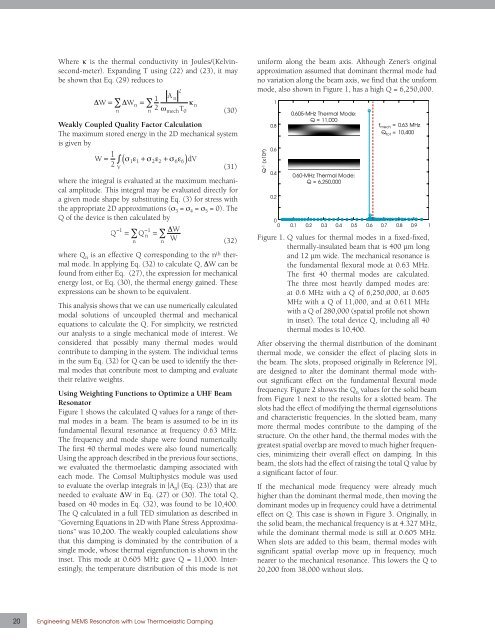Each - Draper Laboratory
Each - Draper Laboratory
Each - Draper Laboratory
Create successful ePaper yourself
Turn your PDF publications into a flip-book with our unique Google optimized e-Paper software.
Where k is the thermal conductivity in Joules/(Kelvinsecond-meter).<br />
Expanding T using (22) and (23), it may<br />
be shown that Eq. (29) reduces to<br />
20 Engineering MEMS Resonators with Low Thermoelastic Damping<br />
(30)<br />
Weakly Coupled Quality Factor Calculation<br />
The maximum stored energy in the 2D mechanical system<br />
is given by<br />
(31)<br />
where the integral is evaluated at the maximum mechanical<br />
amplitude. This integral may be evaluated directly for<br />
a given mode shape by substituting Eq. (3) for stress with<br />
the appropriate 2D approximations (s 3 = s 4 = s 5 = 0). The<br />
Q of the device is then calculated by<br />
(32)<br />
where Qn is an effective Q corresponding to the nth thermal<br />
mode. In applying Eq. (32) to calculate Q, DW can be<br />
found from either Eq. (27), the expression for mechanical<br />
energy lost, or Eq. (30), the thermal energy gained. These<br />
expressions can be shown to be equivalent.<br />
This analysis shows that we can use numerically calculated<br />
modal solutions of uncoupled thermal and mechanical<br />
equations to calculate the Q. For simplicity, we restricted<br />
our analysis to a single mechanical mode of interest. We<br />
considered that possibly many thermal modes would<br />
contribute to damping in the system. The individual terms<br />
in the sum Eq. (32) for Q can be used to identify the thermal<br />
modes that contribute most to damping and evaluate<br />
their relative weights.<br />
Using Weighting Functions to Optimize a UHF Beam<br />
Resonator<br />
Figure 1 shows the calculated Q values for a range of thermal<br />
modes in a beam. The beam is assumed to be in its<br />
fundamental flexural resonance at frequency 0.63 MHz.<br />
The frequency and mode shape were found numerically.<br />
The first 40 thermal modes were also found numerically.<br />
Using the approach described in the previous four sections,<br />
we evaluated the thermoelastic damping associated with<br />
each mode. The Comsol Multiphysics module was used<br />
to evaluate the overlap integrals in |An | (Eq. (23)) that are<br />
needed to evaluate DW in Eq. (27) or (30). The total Q,<br />
based on 40 modes in Eq. (32), was found to be 10,400.<br />
The Q calculated in a full TED simulation as described in<br />
“Governing Equations in 2D with Plane Stress Approximations”<br />
was 10,200. The weakly coupled calculations show<br />
that this damping is dominated by the contribution of a<br />
single mode, whose thermal eigenfunction is shown in the<br />
inset. This mode at 0.605 MHz gave Q = 11,000. Interestingly,<br />
the temperature distribution of this mode is not<br />
uniform along the beam axis. Although Zener’s original<br />
approximation assumed that dominant thermal mode had<br />
no variation along the beam axis, we find that the uniform<br />
mode, also shown in Figure 1, has a high Q = 6,250,000.<br />
Q -1 (x10 4)<br />
1<br />
0.8<br />
0.6<br />
0.4<br />
0.2<br />
0.605-MHz Thermal Mode:<br />
Q = 11,000<br />
0.60-MHz Thermal Mode:<br />
Q = 6,250,000<br />
f mech = 0.63 MHz<br />
Q tot = 10,400<br />
0<br />
0 0.1 0.2 0.3 0.4 0.5 0.6 0.7 0.8 0.9 1<br />
Figure 1. Q values for thermal modes in a fixed-fixed,<br />
thermally-insulated beam that is 400 µm long<br />
and 12 µm wide. The mechanical resonance is<br />
the fundamental flexural mode at 0.63 MHz.<br />
The first 40 thermal modes are calculated.<br />
The three most heavily damped modes are:<br />
at 0.6 MHz with a Q of 6,250,000, at 0.605<br />
MHz with a Q of 11,000, and at 0.611 MHz<br />
with a Q of 280,000 (spatial profile not shown<br />
in inset). The total device Q, including all 40<br />
thermal modes is 10,400.<br />
After observing the thermal distribution of the dominant<br />
thermal mode, we consider the effect of placing slots in<br />
the beam. The slots, proposed originally in Reference [9],<br />
are designed to alter the dominant thermal mode without<br />
significant effect on the fundamental flexural mode<br />
frequency. Figure 2 shows the Qn values for the solid beam<br />
from Figure 1 next to the results for a slotted beam. The<br />
slots had the effect of modifying the thermal eigensolutions<br />
and characteristic frequencies. In the slotted beam, many<br />
more thermal modes contribute to the damping of the<br />
structure. On the other hand, the thermal modes with the<br />
greatest spatial overlap are moved to much higher frequencies,<br />
minimizing their overall effect on damping. In this<br />
beam, the slots had the effect of raising the total Q value by<br />
a significant factor of four.<br />
If the mechanical mode frequency were already much<br />
higher than the dominant thermal mode, then moving the<br />
dominant modes up in frequency could have a detrimental<br />
effect on Q. This case is shown in Figure 3. Originally, in<br />
the solid beam, the mechanical frequency is at 4.327 MHz,<br />
while the dominant thermal mode is still at 0.605 MHz.<br />
When slots are added to this beam, thermal modes with<br />
significant spatial overlap move up in frequency, much<br />
nearer to the mechanical resonance. This lowers the Q to<br />
20,200 from 38,000 without slots.

















